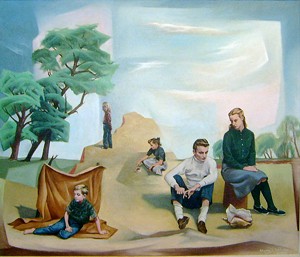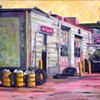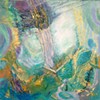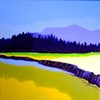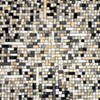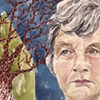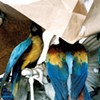Published June 30, 2010 at 7:23 a.m.
Circles of sophisticated artists and writers seem constantly to develop and disband in the Burlington area, leavening the cultural life of the city across generations. Seventy years ago two Burlington painters, comrades in the WPA easel painting project, formed the heart of such a circle. Francis Colburn (1909-1984) and Ronald Slayton (1910-1992) became lifelong friends, and both had a presence at the University of Vermont. “A Centennial Celebration: The Art of Francis Colburn and Ronald Slayton,” on view this summer at UVM’s Fleming Museum, celebrates the centenary of the artists’ births. Colburn was born in Fairfax; Slayton came from Barre. More than 50 paintings, drawings and prints have been assembled for the exhibition.
As the works of both men hang side by side, it’s impossible not to compare and contrast their aesthetics. Both were in complete command of the technical aspects of painting, but they used their talents somewhat differently. Echoes of cubism and surrealism in Colburn’s work suggest he was the more analytic of the pair. Crystalline geometric elements find shape in several of his canvasses. Slayton’s pieces seem more emotionally driven. Elements of the Ashcan School and the darker side of social realism flavor his works. Both witnessed José Clemente Orozco’s “Epic of American Civilization” as it was produced at Dartmouth College over the years 1932 to ’34, but Slayton seems to have been more directly influenced by the Mexican muralist.
The Vermont artists show us how they viewed themselves in a pair of self-portraits, both from 1935. Slayton’s background is black, and a harsh overhead light illuminates his muscular face. Colburn appears in a white room, keenly studying his smooth features. Architectonic details — a window, a slightly open door — enhance the coolness of the scene.
Slayton’s 1937 “Courtroom” focuses on one of the purest expressions of democracy in our society: the moment when a judge swears in a jury of average citizens — all white men in this case, but such were the times. The jurors appear melded together in that instant, their right hands raised and looming large. The raised hand of the judge is just as large as those of the jurors, though he is a smaller figure at left in the painting. This is no Norman Rockwell treatment; Slayton’s view is pithy and patriotic without being saccharine. A viewer can almost imagine the rhythmic oath being voiced, as if some tribal ceremony were in progress.
The figures in Colburn’s “Variations on a Theme” have a quite different collective presence in their almost surreal setting — ostensibly outdoors, it has the formality of studio setup with a faux backdrop. The 36-by-41-inch oil is a family portrait, but the two parents and three children are oddly separated from one another. There is no eye contact, no emotion. The land rises behind the children, and clouds and trees are solid objects. Colburn’s composition is as impeccable as his brush work, and his colors are subdued hues of tan, pale blue and green.
“Granite Quarry,” also by Colburn, is a rare example of three-point perspective. Besides the two vanishing points at right and left, Colburn subtly and masterfully added a vanishing point below the picture plane, beyond the image, to deepen the quarry’s pit. The men and machines in the quarry seem like ants serving in an inverted anthill.
Slayton’s later watercolors are not to be overlooked, though they are quieter and more peaceful than the pieces in his Depression-era collection. His 1975 wet-on-wet “Purple Mountains Majesty” seems to have been painted with joy, as colors effortlessly flow together and harmonize. Rich purples laid down with a few broad strokes are framed by evergreen branches made with a slightly dryer, smaller brush. The white passages of negative space are crisp, and a few watery brushes of indigo and blue form a high, calm sky.
Perhaps some future Vermont painters are being born this week whose lives will be celebrated 100 years from now at a 22nd-century Fleming Museum. And, considering the vibrant culture of this corner of New England, our descendants shouldn’t be a bit surprised.
Want to see for yourself?
A Centennial Celebration: The Art of Francis Colburn and Ronald Slayton,” Fleming Museum, UVM, Burlington. Through August 29.
More By This Author
Speaking of Art,
-

Q&A: Catching Up With the Champlain Valley Quilt Guild
Apr 10, 2024 -

Video: The Champlain Valley Quilt Guild Prepares for Its Biennial Quilt Show
Apr 4, 2024 -

Q&A: Meet a Family in Waterbury That Embraces Halloween Year-Round
Feb 14, 2024 -

Video: Goth Family in Waterbury: Sarah, Jay and Zarek Vogelsang-Card
Feb 8, 2024 -

Q&A: Art Entrepreneurs Tessa and Torrey Valyou Celebrate 15 Years of New Duds
Oct 11, 2023 - More »
Comments
Comments are closed.
From 2014-2020, Seven Days allowed readers to comment on all stories posted on our website. While we've appreciated the suggestions and insights, right now Seven Days is prioritizing our core mission — producing high-quality, responsible local journalism — over moderating online debates between readers.
To criticize, correct or praise our reporting, please send us a letter to the editor or send us a tip. We’ll check it out and report the results.
Online comments may return when we have better tech tools for managing them. Thanks for reading.




































